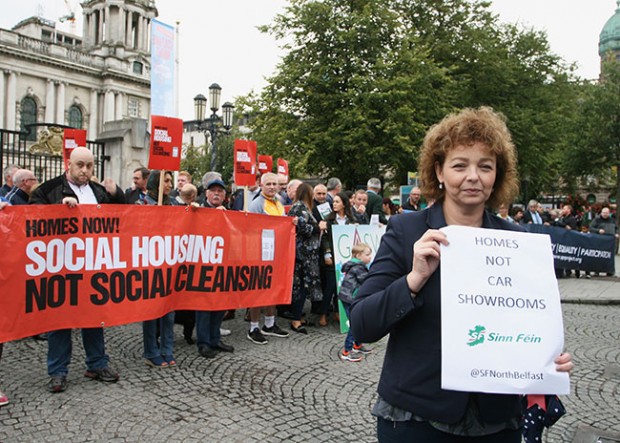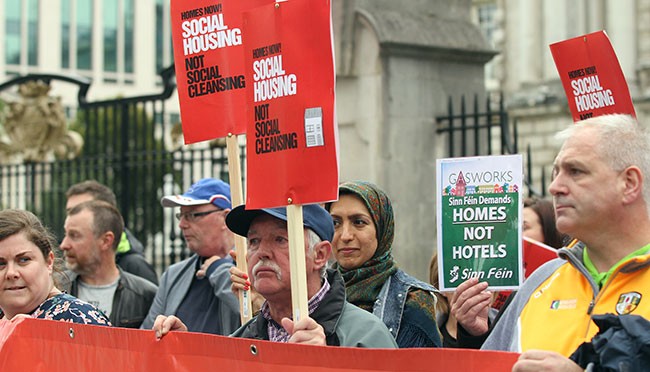27 November 2017 Edition
Housing still contentious 50 years after civil rights struggle
BELFAST HOUSING

• Sinn Féin Housing spokesperson Carál Ní Chuilín MLA joins residents calling for ‘Homes, Not Car Showrooms’
Residents have taken to the streets to protest at decisions by Belfast City Council to refuse to zone land for social housing
HOUSING ALLOCATION was one of the central issues for civil rights campaigners in the 1960s as public housing allocated by local councils – invariably controlled by the Unionist Party – practised widespread discrimination against the Catholic/nationalist community.
Yet, almost two decades after the Good Friday Agreement, housing provision is still a bone of contention.
Threats by the unionist Ulster Volunteer Force that have forced Catholic families to flee their homes in a shared housing initiative in Belfast show sectarianism in its sharpest light. For numerous families living in overcrowded and socially deprived areas of the North, however, the failure of the statutory bodies to provide adequate housing smacks more of the discrimination of the 1960s/1970s unionist regime in Stormont than the bully-boy tactics of the UVF.
In recent months, residents of north and south Belfast have taken to the streets to protest at decisions by Belfast City Council to refuse to zone land for social housing, instead favouring private developments as well as commercial and retail projects.
Figures published by the Housing Executive as far back 2008 predicted that 95% of the projected need for new homes in north Belfast would, by 2012, be in the Catholic community. It is clear this is a systemic problem and raises the question as to how much has changed for nationalists since the 1960s when the civil rights movement demanded an end to housing discrimination.
Cantrell Close became a headline name in June of this year when, in a clear demonstration of loyalist intimidation in advance of the ‘marching season’, the mixed neighbourhood development was bedecked with UVF paramilitary and other unionist regalia clearly aimed at marking the area for loyalism.
The PSNI visited four Catholic families in the development on Tuesday night 26 September to inform them they were under threat, leading them to abandon their homes.
What gave the Cantrell Close story an added edge was the fact that it was promoted as a ‘flagship’ (no pun intended), cross-community housing development built as part of the Stormont Executive’s ‘Together: Building a United Communities’ (T:BUC) programme.
Launched in 2013 by the then First and Deputy First Ministers Peter Robinson and Martin McGuinness, the T:BUC strategy, as it become known, had as its vision “a united community based on equality of opportunity, the desirability of good relations and reconciliation – one which is strengthened by its diversity, where cultural expression is celebrated and embraced and where everyone can live, learn, work and socialise together, free from prejudice, hate and intolerance”.

• South Belfast DUP MP Emma Little-Pengelly and DUP Councillors Paul Porter (top right) and Jonathan Craig (bottom right)
In the section on housing, T:BUC quotes Life & Times Surveys which “have consistently shown significant preferences for mixed religion neighbourhoods”.
Yet the surveys go on to say:
“Despite this, the majority of social housing estates remain segregated in terms of religion. Evidence from the Department for Social Development suggests that, when people are given the choice, the vast majority will choose to go on a waiting list in a single identity area in keeping with their own perceived identity.”
Given the events in Cantrell Close, it would seem that nationalists stay in their own districts because it’s safer and it’s not just a case of “keeping with their own perceived identity”.
It’s also worth reminding ourselves that South Belfast DUP MP Emma Little-Pengelly was a junior minister when T:BUC was launched, which makes her insipid response to the intimidation all the more reprehensible.
Little-Pengelly chose to take a softly-softly approach by claiming that some local people support the flags rather than join in the condemnation of the loyalist actions and challenge the UVF directly.
“There were some people who were very supportive of the flags . . . the majority of people said to me ‘We understand that the flags have gone up, but we also understand that they will come back down again.’ Really they didn’t want a public fuss around this matter.”
When it emerged that four Catholic families were forced out, Little-Pengelly proffered the information that she had “offered to remove the flags” herself.
Unfortunately for the DUP, news emerged on 21 September that linked senior party members in Lisburn to a row over housing allocation.
Proclaiming he would fight for “local housing for local families”, DUP Councillor Paul Porter was backing a call from the Seymour Hill & Conway Residents’ Association (SHCRA), encouraging loyalists to “get yourself on the list and let’s get these houses filled up with people from [the] loyalist/unionist community”.
The call, posted on social media, was referring to a 98-unit development on the site of the old Dunmurry High School on the outskirts of west Belfast and which could be used to alleviate the housing shortage facing nationalist families in the area.
To compound the DUP’s embarrassment, the post suggested that applicants contact DUP Councillor Jonathan Craig whose wife sits on the board of SHCRA.
The real difficulty for the DUP in all this is that the slogans “local houses for local people” and “locals only” have become another way of telling people who are not unionist or white to stay out.
Despite the aspirational promises of T:BUC and its laudable aim to bring the communities in the North together, the unionist leopard seemingly is not for changing its spots.
Belfast communities accuse council

WHILE the blatant sectarianism of loyalist thugs grabs the headlines, the underlying problems in housing are building into a crisis.
Campaigners argue that it is already at crisis point in north Belfast and south Belfast and recent protests opposing Belfast City Council’s decisions to support private commercial developers rather than opt for social housing in areas of acute housing stress are an indication of people’s anger.
And that anger was apparent when Sinn Féin north Belfast Councillor J. J. Magee accused unionist members of Belfast City Council’s planning committee of “sectarianism” over a decision to support private and commercial plans for the Market and Hillview sites rather than have the lands for social housing.
As the council met to debate the issue, residents and campaigners from the Market and north Belfast held a protest outside City Hall, accusing the council of a “land-grab”.
Speaking at the meeting, Sinn Féin Councillor Gerard McCabe described the Hillview site, located on Crumlin Road, as “a failed retail site” that should be used for housing.
McCabe also pointed out to An Phoblacht:
“Since the closure of Dunnes Stores in 2007 and the collapse of plans by ASDA to locate there in 2011, the complex has lain largely vacant.”
Unsurprisingly, unionist politicians – particularly the DUP’s north Belfast representatives – have been most vociferous in supporting the commercial proposals for the disused site, echoing claims by owners Killultagh that it has “the potential to bring more than 300 jobs to the area”.
The investment, speculated to be worth more than £3million, centres on extensive construction work on the centre’s buildings as well as the creation of several food and drink outlets with the possibility that a major supermarket and a large multinational retailer will take up a tenancy.
No less a body than the United Nations Committee on Economic, Social and Cultural Rights in its report dated 24 June 2016 says it is “concerned about the persistent [my emphasis] inequality in the access to adequate housing in north Belfast, affecting in particular Catholic families”.
The North’s Equality Commission, in findings published in April this year, disclosed that Catholic families across the North were likely to wait longer to be housed that their Protestant counterparts, thus adding to pressure on areas with an already low social housing stock.
In south Belfast, the waiting time for a Catholic family to be housed is 27 months and so the demand in areas such as the Market area is steadily building as is the housing stress.
In an angry response to the recent decision by Belfast City Council, Sinn Féin Councillor Deirdre Hargey accused the Planning Committee of reneging on commitments to build social housing on the “northern fringes” of the area, instead opting to build a 14-storey office block and hotels “to the detriment of the residents, the community and an area of extreme social deprivation”.
According to Hargey”
“This area was zoned as one block for housing in the Belfast Metropolitan Plan in 2014. However, while office blocks, business units and hotels have gone up – and been welcomed by local people – there has been no sign of the promised housing.”
Fionntán Hargey of the ‘Housing Now’ campaign said the Market area had historically been chipped away over the years:
“For sustainability it needs more social housing. There’s currently 106 families on the waiting list; 86 of those families are designated as being in acute housing stress.”




